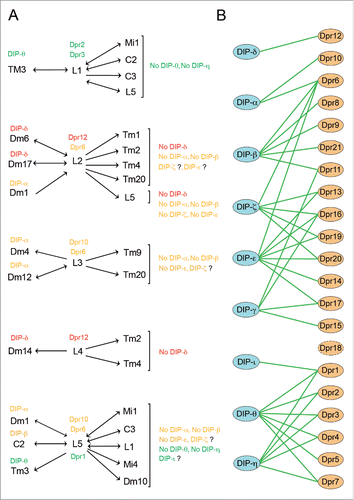Figures & data
Figure 1. Summary of cognate Dpr-DIP expression in L1-L5 neurons and a subset of their synaptic partners. (A.) Color coded Dpr-DIP interactions between lamina monopolar neurons and a subset of their synaptic partners. Single headed arrow indicates that the cell of origin is presynaptic to the receiving cell, which is the postsynaptic one. Thus, synaptic input goes in just one direction. Double headed arrows denote that both cells make connections onto each other. A subset of the Dprs expressed in each lamina neuron is annotated. Synaptic partners to the left of lamina neurons express at least a cognate DIP to the Dprs annotated in the corresponding lamina neuron. Synaptic partners to the right of lamina neurons do not show expression of analyzed cognate DIPsCitation18 (Tan, Xiao and Zipursky unpublished). Question marks indicate that the expression analysis of these DIPs, which could interact with annotated Dprs, is in progress. See L3 as an example. L3 expresses Dpr6 and Dpr10. Dpr10 can only interact with DIP-α, however Dpr6 can interact with DIPs –α, -β,−ζ and –ϵ. Tm9 and Tm20 do not express DIP-α or DIP-β. DIP-ζ and DIP-ϵ expression is being analyzed. Note that among the 10 Dpr-DIP predicted interactions between synaptic partners, DIP is expressed in the postsynaptic cell with one exception: Dm1, which expresses DIP-α, is presynaptic to L2. (B.) Summary of the Dpr-DIP interactomeCitation22,24. This diagram depicts in vitro interactions between Dprs and DIPs. Note that one Dpr can interact with more that one DIP.

